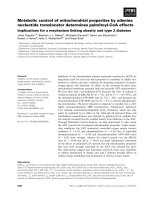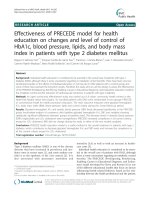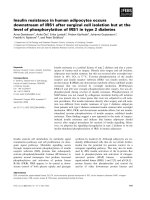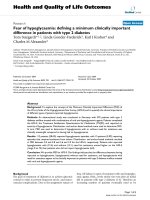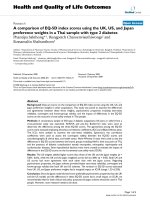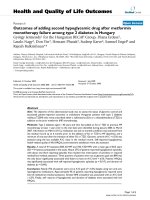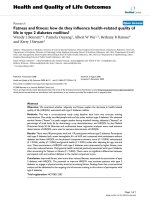mechanisms of type 2 diabetes
Bạn đang xem bản rút gọn của tài liệu. Xem và tải ngay bản đầy đủ của tài liệu tại đây (1.53 MB, 31 trang )
Mechanisms of Type 2 Diabetes
Adapted from Saltiel et al. Diabetes 1996; 45:1661-1669.
Liver
Pancreas
Peripheral Tissues
(Muscle and Adipose)
Increased glucose
production
Glucose
Impaired insulin
secretion
Receptor + postreceptor
defects
Insulin
resistance
Natural History of Type 2
Diabetes
Glucose
Relative to normal
5
11
8
17
14
20
-10 -5
0 5 10 15 20
25 30
0
100
200
50
150
Post-prandial glucose
Fasting glucose
Insulin resistance
Insulin level
Years
At risk for diabetes
Beta-cell dysfunction
250
R.M. Bergenstal, International Diabetes Center
mmol/L
(%)
Diabetic complications:
1.Diabetic Nephropathy.
2. Diabetic Neuropathy.
3. Diabetic Retinopathy
Diabetic Nephropathy
Over 40% of new cases of end-
stage renal disease (ESRD) are
attributed to diabetes.
In 2001, 41,312 people with
diabetes began treatment for end-
stage renal disease.
In 2001, it cost $22.8 billion in
public and private funds to treat
patients with kidney failure.
Minorities experience higher than
average rates of nephropathy and
kidney disease
Diabetic Neuropathy
•
About 60-70% of people with diabetes
have mild to severe forms of nervous
system damage, including:
−
Impaired sensation or pain in the feet or
hands
−
Slowed digestion of food in the stomach
−
Carpal tunnel syndrome
−
Other nerve problems
•
More than 60% of nontraumatic lower-
limb amputations in the United States
occur among people with diabetes.
Diabetic Retinopathy
•
Diabetic retinopathy is the most
common cause of new cases of
blindness among adults 20-74 years
of age.
•
Each year, between 12,000 to
24,000 people lose their sight
because of diabetes.
•
During the first two decades of
disease, nearly all patients with type
1 diabetes and over 60% of patients
with type 2 diabetes have
retinopathy
Proportion of patients with cardiovascular disease
increases with duration of type 2 diabetes
Years T2DM
<=2 3-5 6-9 10-14 15+
15%
21%
24%
29%
48%
Harris,S et al. CDA 2003; Type 2 Diabetes and Associated Complications in Primary Care in Canada: The Impact of Duration of Disease on Morbidity Load.
Stratton IM, et al. UKPDS 35. BMJ 2000; 321:405–412.
UKPDS: the benefits of improved
glycemic control
•
Improved glycemic control significantly reduces risk
of diabetes-related complications
•
UKPDS results indicated that a 1% reduction in A1C
would reduce the risk of microvascular complications
by 37%, but have less effect (16%) on
macrovascular complications
•
Further improvement in sustained glycemic control
and reduction in the burden of cardiovascular
disease are needed
Adapted from Stratton IM, et al. UKPDS 35. BMJ 2000; 321:405–412.
UKPDS: decreased risk of diabetes-related complications
associated with a 1% decrease in A1C
Percentage increase in relative risk
corresponding to a 1% rise in HbA1C
**
Any
diabetes-
related
endpoint
21%
**
Diabetes-
related
death
21% **
All
cause
mortality
14%
*
Stroke
12%
**
Peripheral
vascular
disease
†
43%
**
Myocardial
infarction
14%
**
Micro-
vascular
disease
37%
**
Cataract
extraction
19%
Observational analysis from UKPDS study data
†
Lower extremity amputation or fatal peripheral vascular disease
*P = 0.035; **P < 0.0001
The UKPDS demonstrated progressive
decline of β-cell function over time
100
80
60
40
P < 0.0001
HOMA model, diet-treated n = 376
Time from diagnosis (years)
100
β-cell function (%)
80
60
40
20
0
Start of treatment
Adapted from Holman RR. Diabetes Res Clin Pract 1998; 40 (Suppl.):S21–S25.
–10 –9 –8 –7 –6 –5 –4 –3 –2 –1 1 2 3 4 5 6
Years T2DM
Proportion of patients with A1C > 7.0
increases with duration of type 2 diabetes
<=2 3-5 6-9 10-14 15+
31%
42%
53%
67%
62%
Harris,S et al. CDA 2003; Type 2 Diabetes and Associated Complications in Primary Care in Canada: The Impact of Duration of Disease on Morbidity Load.
Activity
•
Insulin-independent
glucose uptake by muscles
•
Increased muscle mass
improves glycemia long-
term
•
Cardiovascular fitness
•
Weight loss
•
150 min/ week plus
resistance training
Lifestyle Intervention
•
The first step in treating type 2 diabetes
•
Nutrition therapy and exercise can improve glycemic control
•
Success of lifestyle intervention related to:
•
patient’s initial fasting plasma glucose level
•
amount of weight loss achieved by patient
•
Only a minority of patients are able to attain treatment
targets using lifestyle intervention alone.
Blood Glucose
Increased insulin
secretion
Decrease in hepatic
glucose production
Increase in glucose uptake
Biguanides
Thiazolidinediones
Sulfonylureas
and CBAs
Thiazolidinediones
Biguanides
Alpha-glucosidase
inhibitors
Decreased digestion of
complex sugars
Mechanisms of Action of
Diabetes Medications
Alpha-Glucosidase Inhibitors:
Mechanisms of Action
1. Intestine: glucose absorption
2. Muscle and adipose
tissue: glucose uptake
3. Pancreas:
insulin secretion
4. Liver: hepatic glucose
output
Insulin resistance
Blood
glucose
Insulin
resistance
Biguanides: Mechanisms of Action
1. Intestine: glucose absorption
2. Muscle and adipose tissue:
Biguanides glucose
utilization
3. Pancreas:
insulin secretion
4. Liver: Biguanides
hepatic glucose output
Insulin
resistance
Insulin resistance
Blood
glucose
Thiazolidinediones:
Mechanisms of Action
Muscle and
adipose tissue
↓ insulin resistance
↑ glucose uptake
Liver
↓ insulin resistance
↓ hepatic glucose
production
Blood
glucose
Pancreas
↓ demand for insulin secretion
↑ beta-cell insulin content
Treatment
Thiazolidinediones:
Mechanism of Insulin Sensitization
Inzucchi, 1999; Yale University, unpublished
Inzucchi, 1999; Yale University, unpublished
Thiazolidinediones:
Mechanism of Insulin Sensitization
Thiazolidinediones:
Mechanism of Insulin Sensitization
Inzucchi, 1999; Yale University, unpublished
Insulin Secretagogues: Mechanisms of Action
1. Intestine:
glucose absorption
2. Muscle and
adipose tissue:
glucose uptake
3. Pancreas:
Insulin secretion
Sulfonylureas
insulin secretion
4. Liver: hepatic glucose
output
Insulin
resistance
Insulin resistance
Blood
glucose
Insulin Secretagogues:
•
Sulfonylureas:
–
Glyburide, gliclazide
–
(Glimipride)
–
Long-acting, powerful
–
Can cause low sugars
•
Carbamoyl Benzoic Acids:
–
Repaglinide (GlucoNorm)
–
Nateglinide (Starlix)
–
Shorter-acting
–
Low sugars less likely
Insulin Secretagogues
•
Watch for hypoglycemia
potential:
–
Any patient with low-normal
sugars
–
Long-acting agents combined
with decreased oral intake:
•
Chlorpropamide (Diabinase)
•
Gliclazide SR (Diamicron MR)
–
Intermediate agents with mild
hyperglycemia:
•
Glyburide
Clinical assessment and initiation of nutrition and physical activity
Mild to moderate hyperglycemia (A1C <9.0%)
Overweight
(BMI ≥25 kg/m
2
)
Non-overweight
(BMI <25 kg/m
2
)
Biguanide alone or in
combination with 1 of:
•
insulin sensitizer*
•
insulin secretagogue
•
insulin
•
alpha-glucosidase
inhibitor
1 or 2
†
antihyperglycemic
agents from different
classes
•
biguanide
•
insulin sensitizer*
•
insulin secretagogue
•
insulin
•
alpha-glucosidase
inhibitor
Add a drug from a different class
or
Use insulin alone or in combination with:
•
biguanide
•
insulin secretagogue
•
insulin sensitizer*
•
alpha-glucosidase inhibitor
Marked hyperglycemia (A1C ≥9.0%)
2 antihyperglycemic agents
from different classes
†
•
biguanide
•
insulin sensitizer*
•
insulin secretagogue
•
insulin
•
alpha-glucosidase
inhibitor
Basal and/or
preprandial insulin
Add an oral
antihyperglycemic agent
from a different
class of insulin*
Intensify insulin
regimen or add
•
biguanide
•
insulin
secretagogue**
•
insulin sensitizer*
•
alpha-glucosidase
inhibitor
If not at targetIf not at targetIf not at targetIf not at target
Timely adjustments to and/or additions of oral antihyperglycemic agents
and/or insulin should be made to attain target A1C within 6 to 12 months
L I F E S T Y L E
Clinical assessment and initiation of nutrition and physical activity
Mild to moderate hyperglycemia (A1C <9.0%)
Overweight
(BMI ≥25 kg/m
2
)
Biguanide alone or in
combination with 1 of:
•
insulin sensitizer*
•
insulin secretagogue
•
insulin
•
alpha-glucosidase
inhibitor
Add a drug from a different class
or
Use insulin alone or in combination with:
•
biguanide
•
insulin secretagogue
•
insulin sensitizer*
•
alpha-glucosidase inhibitor
If not at target
Marked hyperglycemia (A1C ≥9.0%)
2 antihyperglycemic agents
from different classes
†
•
biguanide
•
insulin sensitizer*
•
insulin secretagogue
•
insulin
•
alpha-glucosidase
inhibitor
Basal and/or
preprandial insulin
Add an oral
antihyperglycemic agent
from a different
class of insulin*
If not at targetIf not at target
Intensify insulin
regimen or add
•
biguanide
•
insulin
secretagogue**
•
insulin sensitizer*
•
alpha-glucosidase
inhibitor
Non-overweight
(BMI <25 kg/m
2
)
1 or 2
†
antihyperglycemic
agents from different
classes
•
biguanide
•
insulin sensitizer*
•
insulin secretagogue
•
insulin
•
alpha-glucosidase
inhibitor
If not at target
Timely adjustments to and/or additions of oral antihyperglycemic agents
and/or insulin should be made to attain target A1C within 6 to 12 months
L I F E S T Y L E

